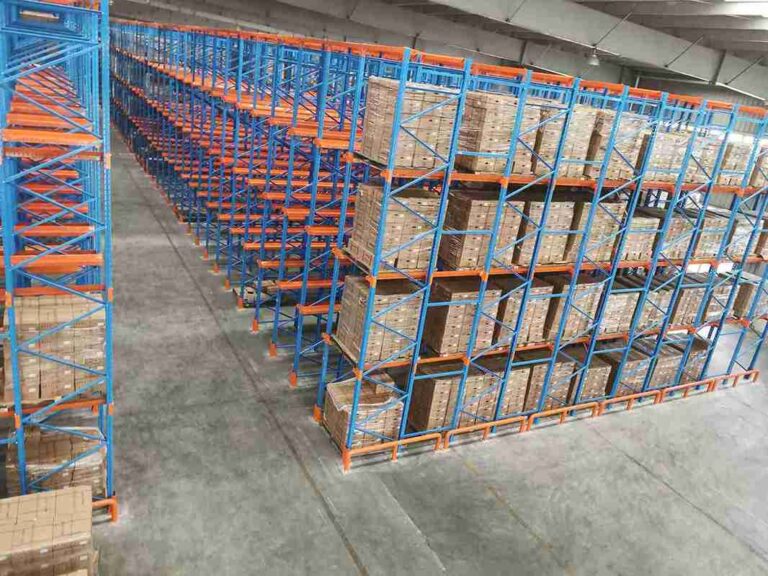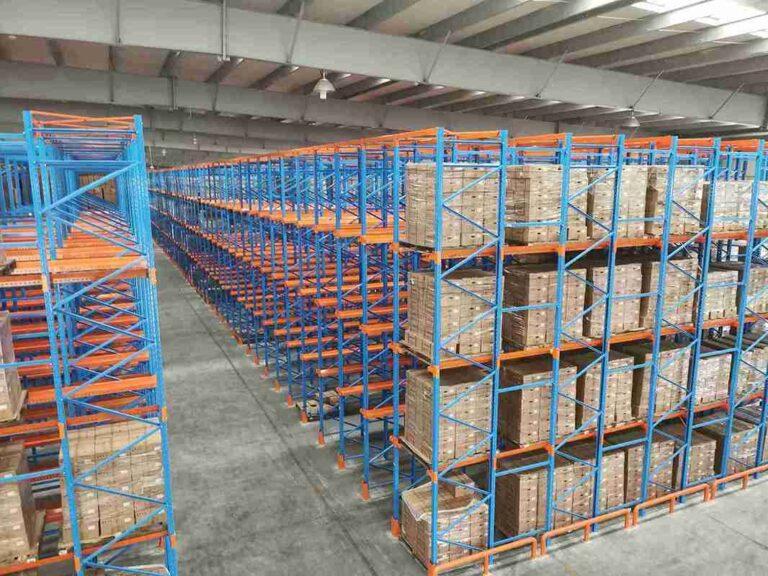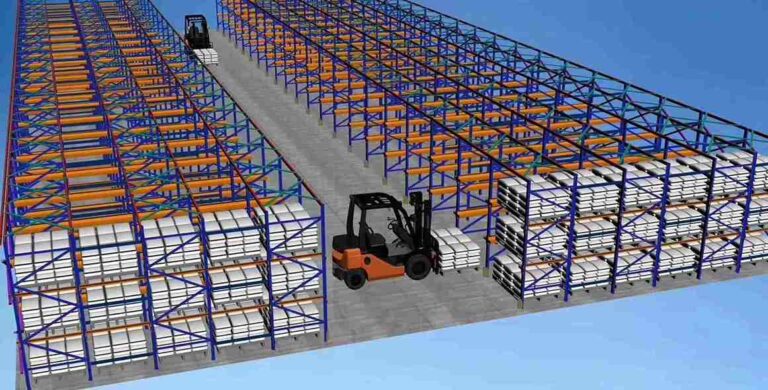📐 "First 50 Enterprise Queries Get Custom 3D Warehouse Design" Plan


Drive in racking drawing engineering analysis showing load paths and stress points
Free Drive-In Racking Design Drawing Review & Compliance Check (OSHA/AS4084 Standards)
In the high-stakes world of warehouse storage, the integrity of a drive-in racking system is non-negotiable. A flawed drive-in racking drawing doesn’t just risk product damage; it risks catastrophic failure, operational shutdown, and team safety. This definitive guide delves into why a professional drive-in racking drawing review is the most critical investment in prevention. We detail a proprietary, no-obligation compliance check process against OSHA and AS4084 standards, explaining how four decades of engineering expertise can identify hidden flaws in plans, ensure structural integrity, and grant peace of mind that comes with a safe, optimized, and compliant storage system. This is more than a review; it’s a partnership in safeguarding assets and personnel.
Introduction: The Unseen Risks Embedded in a Warehouse Blueprint
When a logistics manager approves a drive-in racking design drawing, they are signing off on the structural backbone of their storage operation. Most professionals review these plans with a keen eye for capacity and layout efficiency. However, the most dangerous flaws within a drive-in racking drawing are often invisible to the untrained eye. A miscalculated beam deflection, an underspecified anchor bolt, an improper consideration of seismic or impact forces—these are the silent failures waiting to happen, buried within the technical schematics.
With over 40 years in the industrial storage solutions sector, forensic analyses on collapsed systems consistently trace the root cause back to a fundamental error in the initial drive-in racking design drawing or its installation. The financial repercussions of a collapse—downtime, lost inventory, regulatory fines—are immense. But they pale in comparison to the human cost. This reality is why a significant portion of engineering resources is dedicated to a proactive, preventative service: A Free Drive-In Racking Design Drawing Review & Compliance Check. The mission is to elevate industry safety standards by placing deep expertise at the disposal of warehouse operators, helping them build a foundation of safety before the first upright is bolted down.
Why a Drive-In Racking Design Drawing Demands Specialized Engineering Scrutiny
Drive-in racking is a marvel of space density, but its underlying drive-in racking design drawing is inherently more complex and vulnerable than simpler selective systems. Unlike open shelving where each level is independent, drive-in systems are interlinked structures. The weight of stored pallets is transferred through the rails and into the upright frames, which also bear the lateral forces from forklifts entering and exiting the bays. This complexity makes every line and calculation on the drive-in racking drawing critically important.
- •Continuous Load Paths: The entire structure, as defined by the drive-in racking design drawing, must create a continuous, unimpeded path for loads to travel from the point of application (the pallet beam) all the way down to the building floor. Any weak link—a connection detail, a weld specification, a base plate design—breaks this path and becomes a point of failure. A comprehensive drive-in racking drawing review meticulously traces this load path.
- •Forklift Impact Dynamics: AGV forklifts and traditional manned vehicles exert tremendous lateral and horizontal forces on guide rails, upright protectors, and beams. A competent drive-in racking drawing must account for these not as abstract concepts, but as measurable, recurring forces. The review process includes a specific analysis of Forklift Impact Loads and whether the drive-in racking design drawing incorporates appropriate safety factors and protective elements.
- •The “Teardrop” Dilemma: The connection between the beam and the upright column—often a teardrop-shaped hook—is a critical focal point in any drive-in racking drawing. Engineers scrutinize the engineering specifications for these connections, ensuring the material grade, weld integrity, and hook geometry detailed in the drive-in racking design drawing can handle not just the static load, but the dynamic shock of a pallet being placed and the forklift nudging the beam.
Decoding the Standards: OSHA vs. AS4084 – The Benchmarks for a Compliant Drawing
A compliance check of a drive-in racking drawing is meaningless without a definitive benchmark. For drive-in racking, two standards dominate the global conversation: the U.S.-centric OSHA guidelines and the more prescriptive Australian AS4084 standard. Understanding the difference is key to a truly robust design and a thorough drive-in racking drawing review.
<h3>OSHA 1910.176(b): The Broad Mandate for Safety</h3>
The Occupational Safety and Health Administration (OSHA) provides a performance-based standard. It states: “Storage of material shall not create a hazard. Bagged, baled, banded, boxed, bundled, or wrapped materials shall be stacked, blocked, interlocked, and limited in height so that they are stable and secure against sliding or collapse.”
While it doesn’t provide explicit engineering formulas for a drive-in racking design drawing, OSHA’s General Duty Clause requires employers to provide a workplace free from recognized hazards. This has been interpreted to mean that rack systems must be designed and installed correctly per a compliant drive-in racking drawing. If a collapse occurs and an investigation reveals a flaw in the drive-in racking drawing, the liability falls on the warehouse owner for failing to ensure a safe design. An OSHA compliance check of a drive-in racking drawing focuses on ensuring the design eliminates “recognized hazards” like:
- •Clearly under-specified components on the drive-in racking drawing.
- •Lack of clear load signage called out on the drive-in racking design drawing.
- •Inadequate aisle widths for the specified forklift.
- •Missing safety locks on beams as detailed in the drive-in racking drawing.
- •Inadequate anchoring details within the drive-in racking design drawing.
<h3>AS4084: The Prescriptive Engineering Blueprint for a Superior Drawing</h3>
The Australian Standard AS4084:2012 “Steel storage racking” is a far more detailed, engineering-first document. It is increasingly becoming the global gold standard for projects worldwide due to its rigorous, mathematical approach, making it the ideal framework for a drive-in racking drawing review. It provides specific formulas for calculating elements that must be present in a drive-in racking design drawing:
- •Load Combinations: How to combine dead loads, live loads, seismic loads, and impact loads within the drive-in racking drawing.
- •Pallet Beam Deflection: Mandating maximum deflection limits to ensure stability and safe forklift operation, a key calculation verified during a drive-in racking drawing review.
- •Connection Design: Detailed requirements for the design and testing of mechanical connectors, which must be explicitly detailed in the drive-in racking drawing.
- •Tolerance and Imperfection: Accounting for real-world imperfections in installation and construction, guiding the tolerances noted on the drive-in racking design drawing.
A drive-in racking drawing that is AS4084 compliant is, by definition, engineered to a state-of-the-art standard. The review process uses AS4084 as its primary technical benchmark because it leaves no room for interpretation, providing the hard numbers that guarantee the safety of the drive-in racking design drawing.
The Proprietary 7-Point Drive-In Racking Drawing Review Process
When a company submits its drive-in racking drawing for review, it undergoes a meticulous, multi-stage analysis conducted by chartered structural engineers. This isn’t a cursory glance; it’s a deep dive into the soul of the storage system defined by the drive-in racking design drawing.
1. Initial Documentation Audit for the Drawing Package
The process begins by ensuring the complete drive-in racking drawing package is present: General Arrangement (GA) plans, elevation views, detailed connection drawings, anchor bolt plans, and a full structural calculation report from the original designer. A missing calculation report for a drive-in racking design drawing is a major red flag, as the drawing alone cannot be fully validated.
2. Structural Calculation Verification Against the Drawing>
This is the core of the drive-in racking drawing review. Engineers independently verify the math behind the drive-in racking design drawing. Using advanced modeling software and the principles of AS4084, they cross-check:
- •Load calculations for each beam level against the capacities shown on the drive-in racking drawing.
- •Upright frame capacity under various load combinations detailed in the drive-in racking design drawing.
- •Connection capacities between beams and uprights as specified in the drive-in racking drawing.
- •Base plate and anchor bolt design against pull-out and shear forces, ensuring the drive-in racking drawing’s specifications are sufficient.
3. Seismic & Dynamic Load Analysis on the Drawing
For warehouses in seismic zones or those using high-speed AGVs and automated forklifts, this is critical. The review assesses whether the drive-in racking design drawing adequately incorporates these dynamic forces. A drive-in racking drawing that works for static loads alone is dangerously incomplete for modern automated environments.
4. Forklift Impact Assessment Guided by the Drawing
The proposed layout on the drive-in racking drawing is analyzed from the perspective of a forklift operator. Are the aisles wide enough? Do the details on the drive-in racking design drawing show uprights adequately protected by guards? Does the drawing specify thicker gauge steel on lower levels or on end-of-aisle columns to resist impact?
5. Component Specification Cross-Check
The review ensures every component specified in the bill of materials attached to the drive-in racking drawing—from the steel grade of the uprights to the type of anchor bolt—matches the required capacities from the calculations. A common error is a disconnect between the design theory and the actual components listed for the drive-in racking design drawing.
6. Installation and Tolerance Review of Drawing Specifications
A perfect drive in racking drawing can be ruined by poor installation. The review process examines the installation notes on the drive in racking design drawing and checks if the design allows for realistic tolerances (plumbness, beam levelness) as per AS4084 guidelines. It also ensures the drive in racking drawing includes clear instructions for anchor bolt torque settings.
7. Load Application & Notice Compliance on the Drawing
Finally, the review ensures the drive in racking design drawing includes clear, unambiguous load signs for each bay, as required by both OSHA and AS4084. Providing templates for compliant load signage is a standard part of the review package, completing the drive in racking drawing’s journey from concept to safe operation.
Beyond the Drawing: Integrating the Review with Automated Systems
Modern warehouses are rarely static. The integration of automated storage and retrieval systems (AS/RS), automated conveyors, and AGV forklifts introduces new variables that must be considered in the drive-in racking drawing. The review process is uniquely positioned to address this complexity, ensuring the drive-in racking design drawing is fit for an automated purpose.
- •AGV Interface Analysis: The precise, repetitive movement of AGVs can create resonance or concentrated wear points on guide rails. A modern drive in racking drawing review must assess the design for these specific wear patterns, ensuring the drive in racking drawing specifies materials and designs that can withstand automated traffic.
- •AS/RS Integration: If the drive in racking is part of a larger automated warehouse system, the review must cover the interface points between the static storage and the automated retrieval machinery as shown on the drive in racking design drawing, ensuring structural compatibility and load transfer is seamless.
- •System-Wide Compliance: An automated warehouse is a single organism. A failure in the racking halts the entire system. The drive in racking drawing review thus considers the racking as the critical infrastructure supporting the automation investment, making the accuracy of the drive in racking drawing paramount.
Case Study: How a Free Drawing Review Prevented a Catastrophic Failure
A recent client, a large cold storage distributor, submitted a drive-in racking design drawing for a new high-bay system. Their internal team had approved the plans from a reputable supplier. During the free drive-in racking drawing review, engineers identified a critical flaw in the anchor bolt calculation. The drive-in racking drawing specified a common bolt type, but verification against the specific concrete strength and the anticipated seismic loads of the region showed a significant shortfall in pull-out capacity.
Under a full load, during a minor seismic event, the entire end-of-aisle frame detailed in the drive in racking drawing was at risk of catastrophic failure. The provided report outlined the miscalculation and specified the correct bolt type and embedment depth for the drive in racking design drawing. The client went back to the supplier, who confirmed the findings. A simple, no-cost change to the drive in racking drawing averted a potential disaster, saving the client millions in potential losses and ensuring workforce safety. This is the tangible value of a second opinion on a critical drive in racking drawing.
How to Claim Your Free Drive In Racking Design Drawing Review
Securing a free compliance check for a drive in racking drawing is a straightforward process designed for efficiency.
- 1.Gather Your Documents: Compile the PDFs of the current drive in racking design drawing, including layout plans, elevation views, connection details, and the structural calculation report.
- 2.Submit via a Secure Portal: Use a form to upload the documents. All submissions, especially sensitive drive in racking drawing files, are treated with strict confidentiality and protected by NDAs.
- 3.Engineering Analysis: The team performs the 7-point drive in racking drawing review, typically completing the initial analysis within 3-5 business days.
- 4.Receive a Comprehensive Report: The client receives a detailed PDF report outlining findings on their drive in racking drawing. It clearly states:
- •Areas of full compliance within the drive in racking design drawing.
- •Any identified concerns, ranked by severity.
- •Clear, actionable recommendations for remediation of the drive in racking drawing.
- •A formal statement of compliance (if applicable).
- 5.Optional Consultation: A free 30-minute video call with an engineer is scheduled to walk through the report on the drive in racking drawing and answer any questions.
There is no obligation. This is a commitment to industry-wide safety. Identifying a problem within a drive in racking design drawing that saves a business from tragedy is the core mission of this service.
Conclusion: The Smartest Investment is the One Made Before Installation
In the realm of industrial storage, true expertise is measured by the disasters prevented. A drive in racking system is a long-term capital investment. Approving its drive-in racking design drawing without the rigorous, independent scrutiny of a seasoned engineering team is an unnecessary and profound risk.
The Free Drive-In Racking Design Drawing Review & Compliance Check is an answer to the industry’s need for greater accountability, higher safety standards, and unwavering professional integrity. It leverages decades of experience with pallet racking, automated material handling, and structural engineering to provide unparalleled peace of mind. Don’t leave the safety of a facility, its inventory, and its team to chance. Submitting the drive in racking drawing for review is the first step in building a future on a foundation certified by experts.
Frequently Asked Questions (FAQs)
Q1: The drive in racking drawing is from a major international supplier. Don’t they already ensure it’s compliant?
While major suppliers have engineering teams, errors can occur due to workload, miscommunication, or using outdated templates. Furthermore, their primary obligation is to their design standards. An independent drive in racking drawing review provides a crucial second set of eyes, verifying compliance against the latest international standards like AS4084, which the original designer may not have fully adhered to. It is a best-practice form of due diligence on any drive in racking design drawing.
Q2: The system has already been installed based on the drive-in racking drawing. Is it too late for a review?
It is never too late for a drive in racking drawing review, but the sooner, the better. A review can still be performed on the as-built system using the original drive in racking design drawing and site photographs. This can identify potential issues, allowing for proactive reinforcement or changes to operational procedures before an incident occurs. Post-installation reviews of the drive in racking drawing are often the catalyst for critical remedial projects.
Q3: Does the review service cover other types of storage system drawings beyond drive-in racking?
Absolutely. The engineering expertise encompasses all types of industrial storage solutions. The same principles of structural integrity, load calculation, and compliance apply to drawings for selective pallet racking, cantilever racking, push back racking, mobile shelving, and mezzanine floors. If a drawing exists for a storage structure, it can be reviewed.
Q4: If the review finds a serious problem in the drive-in racking drawing, is there an obligation to use a specific company to fix it?
Not at all. There is zero obligation. The goal is safety first. The report provided will contain detailed, independent recommendations for the drive in racking drawing that the client can take to their original supplier or any other contractor to implement. The service provides the engineering analysis; the client chooses how to execute the solution. A quote for remediation can be provided, but the choice is always the client’s.
Q5: How is this service free? What’s the catch?
There is no catch. The service is funded as a commitment to industry safety and as a leading marketing initiative. By demonstrating profound expertise and value upfront by thoroughly analyzing a client’s drive in racking design drawing, it builds trusted, long-term relationships with safety-conscious leaders. It is an investment in the community and the industry’s future.
Welcome to contact us, if you need warehouse rack CAD drawings. We can provide you with warehouse rack planning and design for free. Our email address is: jili@geelyracks.com




